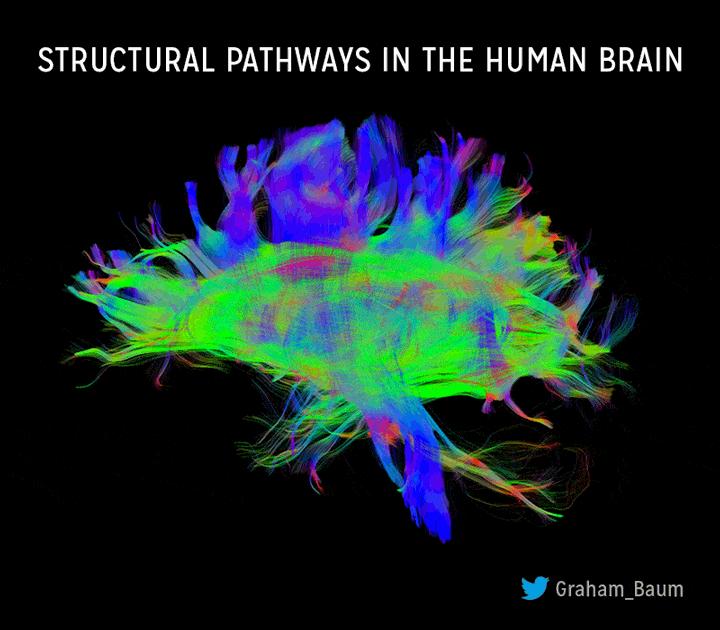Penn study shows developing brain networks support cognition in youth

Credit: Graham Baum
PHILADELPHIA — The human brain is organized into circuits that develop from childhood through adulthood to support executive function–critical behaviors like self-control, decision making, and complex thought. These circuits are anchored by white matter pathways which coordinate the brain activity necessary for cognition. However, little research exists to explain how white matter matures to support activity that allows for improved executive function during adolescence–a period of rapid brain development.
Researchers from the Lifespan Brain Institute of the Perelman School of Medicine at the University of Pennsylvania and Children’s Hospital of Philadelphia applied tools from network science to identify how anatomical connections in the brain develop to support neural activity underlying these key areas. The findings were published in the Proceedings of the National Academy of Sciences.
“By charting brain development across childhood and adolescence, we can better understand how the brain supports executive function and self-control in both healthy kids and those with different mental health experiences,” said the study’s senior author Theodore Satterthwaite, MD, an assistant professor of Psychiatry at Penn. “Since abnormalities in developing brain connectivity and deficits in executive function are often linked to the emergence of mental illness during youth, our findings may help identify biomarkers of brain development that predict cognitive and clinical outcomes later in life.”
In this study, the researchers mapped structure-function coupling–the degree to which a brain region’s pattern of anatomical connections supports synchronized neural activity. This could be thought of like a highway, where the anatomical connections are the road and the functional connections are the traffic flowing along those roads. Researchers mapped and analyzed multi-modal neuroimaging data from 727 participants ages 8 to 23 years, and three major findings emerged.
First, the team found that regional variability in structure-function coupling was inversely related to the complexity of the function a given brain area is responsible for. Higher structure-function coupling was found in parts of the brain that are specialized for processing simple sensory information, like the visual system. In contrast, there was lower structure-function coupling in complex parts of the brain that are responsible for executive function and self-control, which require more abstract and flexible processing.
Results showed that structure-function coupling also aligned with known patterns of brain expansion over the course of primate evolution. Previous work comparing human, ape, and monkey brains has showed that sensory areas like the visual system are highly conserved across primate species and have not expanded much during recent evolution. In contrast, association areas of the brain, such as the prefrontal cortex, have expanded dramatically over the course of primate evolution. This expansion may have allowed for the emergence of uniquely complex human cognitive abilities. The team found that the brain areas which expanded rapidly during evolution had lower structure-function coupling, while simple sensory areas that have been conserved in recent evolution had higher structure-function coupling.
Researchers also found that structure-function coupling increased throughout childhood and adolescence in complex frontal brain regions. These are the same regions that tend to have lower baseline structure-function coupling, are expanded compared to monkeys, and are responsible for self-control. The prolonged development of structure-function coupling in these regions may allow for improved executive function and self-control that develops into adulthood. Indeed, the team found that higher structure-function coupling in the lateral prefrontal cortex–a complex brain area which plays important roles in self-control–was associated with better executive function.
“These results suggest that executive functions like impulse control–which can be particularly challenging for children and adolescents–rely in part on the prolonged development of structure-function coupling in complex brain areas like the prefrontal cortex,” explained lead author Graham Baum, PhD, a postdoctoral fellow at Harvard University, who was a Penn neuroscience PhD student during the time of the research. “This has important implications for understanding how brain circuits become specialized during development to support flexible and appropriate goal-oriented behavior.”
###
Additional Penn co-authors include Zaixu Cui, David R. Roalf, Bart Larsen, Matthew Cieslak, Philip A. Cook, Cedric H. Xia, Tyler M. Moore, Kosha Ruparel. Desmond Oathes, Russell T. Shinohara, Raquel E. Gur, Ruben C. Gur, and Danielle S. Bassett.
This work was supported by the National Institute of Mental Health (F31MH115709, R01MH113550, MH089983, MH089924, R01MH107703, R01MH112847, R01MH107235, P50MH096891, K01MH102609, R01NS085211, RF1MH116920). Additional support was provided by the Lifespan Brain Institute.
Penn Medicine is one of the world’s leading academic medical centers, dedicated to the related missions of medical education, biomedical research, and excellence in patient care. Penn Medicine consists of the Raymond and Ruth Perelman School of Medicine at the University of Pennsylvania (founded in 1765 as the nation’s first medical school) and the University of Pennsylvania Health System, which together form a $7.8 billion enterprise.
The Perelman School of Medicine has been ranked among the top medical schools in the United States for more than 20 years, according to U.S. News & World Report’s survey of research-oriented medical schools. The School is consistently among the nation’s top recipients of funding from the National Institutes of Health, with $425 million awarded in the 2018 fiscal year.
The University of Pennsylvania Health System’s patient care facilities include: the Hospital of the University of Pennsylvania and Penn Presbyterian Medical Center–which are recognized as one of the nation’s top “Honor Roll” hospitals by U.S. News & World Report–Chester County Hospital; Lancaster General Health; Penn Medicine Princeton Health; and Pennsylvania Hospital, the nation’s first hospital, founded in 1751. Additional facilities and enterprises include Good Shepherd Penn Partners, Penn Home Care and Hospice Services, Lancaster Behavioral Health Hospital, and Princeton House Behavioral Health, among others.
Penn Medicine is powered by a talented and dedicated workforce of more than 40,000 people. The organization also has alliances with top community health systems across both Southeastern Pennsylvania and Southern New Jersey, creating more options for patients no matter where they live.
Media Contact
Hannah Messinger
[email protected]
267-240-2448
Related Journal Article
http://dx.




